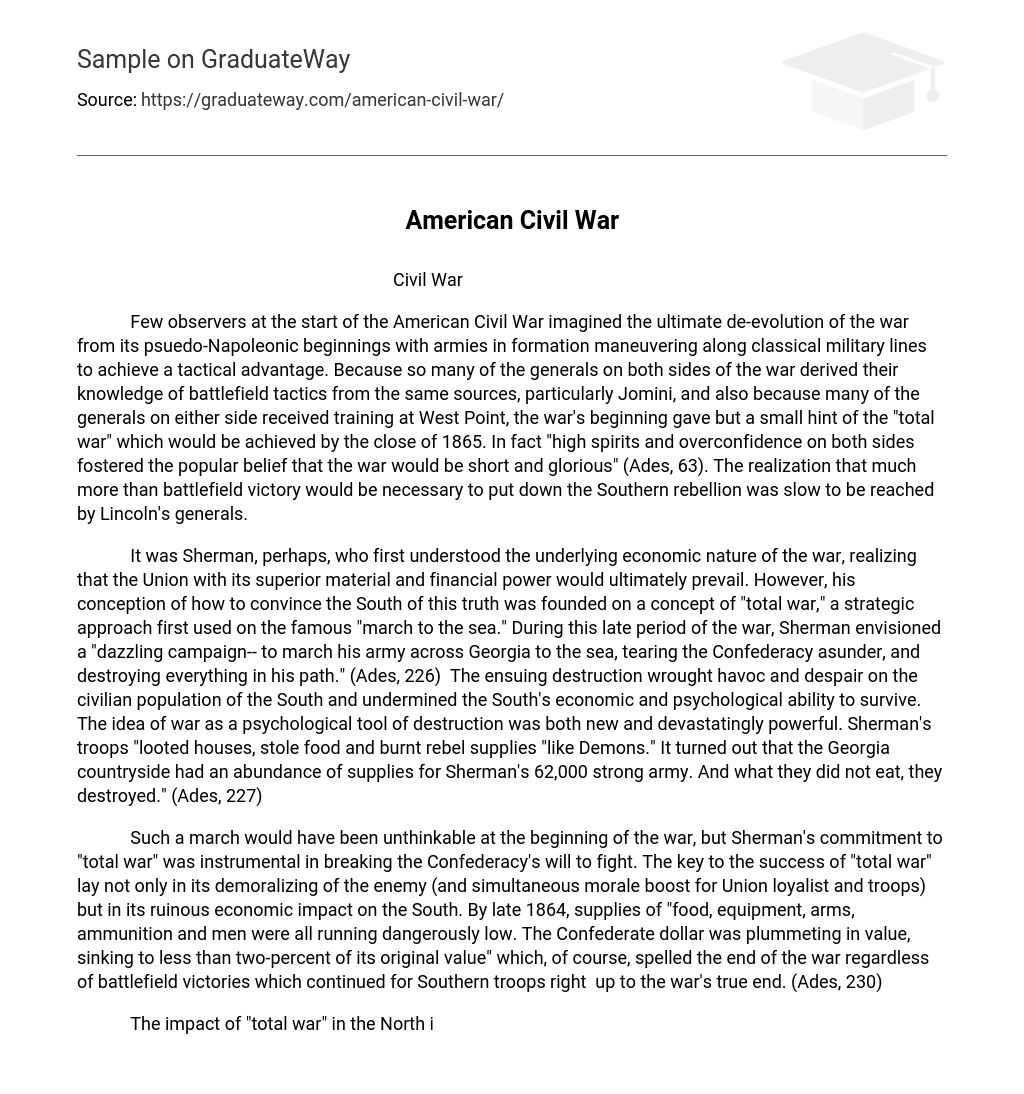Few observers at the start of the American Civil War imagined the ultimate de-evolution of the war from its psuedo-Napoleonic beginnings with armies in formation maneuvering along classical military lines to achieve a tactical advantage. Because so many of the generals on both sides of the war derived their knowledge of battlefield tactics from the same sources, particularly Jomini, and also because many of the generals on either side received training at West Point, the war’s beginning gave but a small hint of the “total war” which would be achieved by the close of 1865. In fact “high spirits and overconfidence on both sides fostered the popular belief that the war would be short and glorious” (Ades, 63). The realization that much more than battlefield victory would be necessary to put down the Southern rebellion was slow to be reached by Lincoln’s generals.
It was Sherman, perhaps, who first understood the underlying economic nature of the war, realizing that the Union with its superior material and financial power would ultimately prevail. However, his conception of how to convince the South of this truth was founded on a concept of “total war,” a strategic approach first used on the famous “march to the sea.” During this late period of the war, Sherman envisioned a “dazzling campaign– to march his army across Georgia to the sea, tearing the Confederacy asunder, and destroying everything in his path.” (Ades, 226) The ensuing destruction wrought havoc and despair on the civilian population of the South and undermined the South’s economic and psychological ability to survive. The idea of war as a psychological tool of destruction was both new and devastatingly powerful. Sherman’s troops “looted houses, stole food and burnt rebel supplies “like Demons.” It turned out that the Georgia countryside had an abundance of supplies for Sherman’s 62,000 strong army. And what they did not eat, they destroyed.” (Ades, 227)
Such a march would have been unthinkable at the beginning of the war, but Sherman’s commitment to “total war” was instrumental in breaking the Confederacy’s will to fight. The key to the success of “total war” lay not only in its demoralizing of the enemy (and simultaneous morale boost for Union loyalist and troops) but in its ruinous economic impact on the South. By late 1864, supplies of “food, equipment, arms, ammunition and men were all running dangerously low. The Confederate dollar was plummeting in value, sinking to less than two-percent of its original value” which, of course, spelled the end of the war regardless of battlefield victories which continued for Southern troops right up to the war’s true end. (Ades, 230)
The impact of “total war” in the North included the raising of African American regiments and the deployment of black troops in combat. In the American Civil War, approximately one-hundred-eighty-thousand African American soldiers and seven thousand white officers in one-hundred sixty-six Union regiments served in four hundred and forty-nine battles. Thirty-seven thousand of these soldiers perished in the war. Meanwhile, Lincoln’s “Emancipation Proclamation” in the North was subsequently followed by a desperate measure on the failing Confederacy’s part: the partial emancipation of their own African American slave class. Black regiments were soon formed, but “it was too little too late.” (Ades, 235) Meanwhile civilians in the South including women were subjected to continued deprivation, violence and fear.
In conclusion, though Confederate forces still stood on the battlefield, “total war” had conclusively decided the war in favor of the Union. Despite the drastic and radical measures of war the Union waged against the South’s civilian population, the terms of military surrender were “magnanimous and fair. The soldiers would be paroled and would not be imprisoned,” thereby demonstrating Lincoln’s insistence that “total war” be brought to a complete close upon the South’ s military surrender. (Ades, 244)
Works Cited
- Ades, Harry. The Little Book of the Civil War. New York; Barnes and Noble Books, 2001. 2 pages 1 source MLA





